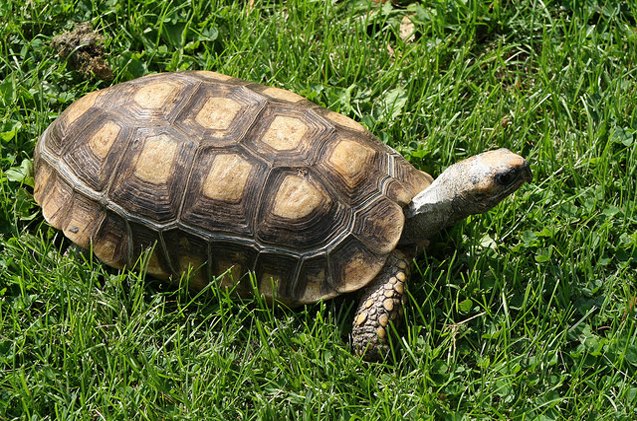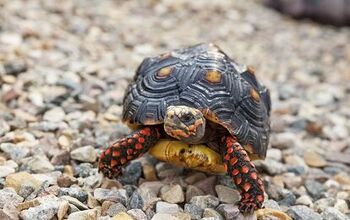Yellow-Footed Tortoise


About Yellow-Footed Tortoise
Like the Red-Footed Tortoise, the Yellow-Footed Tortoise is one of the most popular and beloved tortoise breeds in the pet trade. These animals can be personable, and they are attractive and hardy, so they are a good choice even for beginners.
If you do decide that you would like to bring a Yellow-Footed Tortoise into your family, just be sure to purchase one from a reputable breeder who can guarantee that the animal was born in captivity, as that will help ensure its already threatened wild populations will be able to thrive.
The Yellow-Footed Tortoise is one of the most popular and beloved tortoise breeds in the pet trade.
You can find the Yellow-Footed Tortoise throughout rainforests that are located in South America, from Venezuela, French Guiana, Guyana, Brazil, and the Amazon basin, to Ecuador, Colombia, Bolivia, and Peru. These animals prefer tropical lowlands and dense rainforest.
Yellow-Footed Tortoises have a flatter and wider shape overall compared to the Red-Footed Tortoise. They also do not have the unique hourglass shaped carapace. Males will typically have a flatter carapace when compared to females, and they will also have tails that are wider and longer, along with an obviously concave plastron.
The Yellow-Footed Tortoise will have a shell that is colored light golden brown.
The Yellow-Footed Tortoise is similar to the Red-Footed Tortoise, but it also has some distinctive features. On the front legs, in particular, there will be yellow scales on the Yellow-Footed Tortoise, while the Red-Footed Tortoise will have red scales.
Also, the Yellow-Footed Tortoise will have a shell that is colored light golden brown. The limbs and the head will be darker than the shell. On top of that, the Yellow-Footed Tortoise will usually feature a yellow mark located behind the eyes. There may even be a few yellow scales found on the legs and head. And every scute of the shell will be black along the edges but will be yellow in the center.
When housing a Yellow-Footed Tortoise indoors, you can use an enclosure that is about 8’x4’ for an adult. Provide your pet with a dish that is filled with fresh, clean water at all times. This dish should be shallow so that your tortoise will not drown, but it should be big enough that he can soak in it. When it comes to substrate, mix peat moss and sand and then add a top layer of cypress mulch in order to trap moisture.
There should be a heat lamp in one area of your Yellow-Footed Tortoise’s enclosure so that he can bask, and the temperature should be around 90°F in this basking area. Also include a UV light and a cooler area complete with a damp hiding place that is located away from the basking area.
These animals are shy, so it is a good idea to provide a variety of hiding places for security and comfort. They can use everything from piles of grass clippings or hay, to big banana leaves and pieces of cork bark as shelter.
If you are planning on housing your Yellow-Footed Tortoise outside when the weather is warm, just make sure that the enclosure is properly secured so that he will not be able to escape and so he will be protected from predators. These enclosures should be around 9 square feet in size. They should also have plenty of plants, such as ferns and low bushes, to block out the sunlight and provide your pet with a place to retreat to when he doesn’t want to be in the sun.
The Yellow-Footed Tortoise is shy, so these animals will not like being handled.
The Yellow-Footed Tortoise is mostly herbivorous, so your pet’s diet should primarily consist of fruits and leafy greens like endive, clover, and dandelion, as a few examples.
You can feed your pet a mix of greens, vegetables, and fruits, as well as flowers, each day or every other day. Good options include collard greens, mustard greens, watercress, escarole, kale, romaine, squash, carrots, pumpkin, zucchini, mango, melon, kiwi, papaya, cantaloupe, and hibiscus.
Avoid giving this tortoise animal protein often. Instead, every three weeks or so, you can provide him with a commercial diet designed for tortoises.
The Yellow-Footed Tortoise is shy, so these animals will not like being handled. Often, they will end up retreating into their shells. However, some animals might be tame and outgoing, particularly if they were born and raised in captivity (another reason to search out the best breeders who can guarantee your tortoise was not taken out of the wild).
Photo credit: barloventomagico/Flickr; Jasper Nance/Flickr; Muzik Hounds/Flickr

Lisa Selvaggio is a freelance writer and editor, and our resident cats-pert, with certifications in pet nutrition and pet first aid. She enjoys producing content that helps people understand animals better so they can give their pets a safe and happy home.
More by Lisa Selvaggio
























